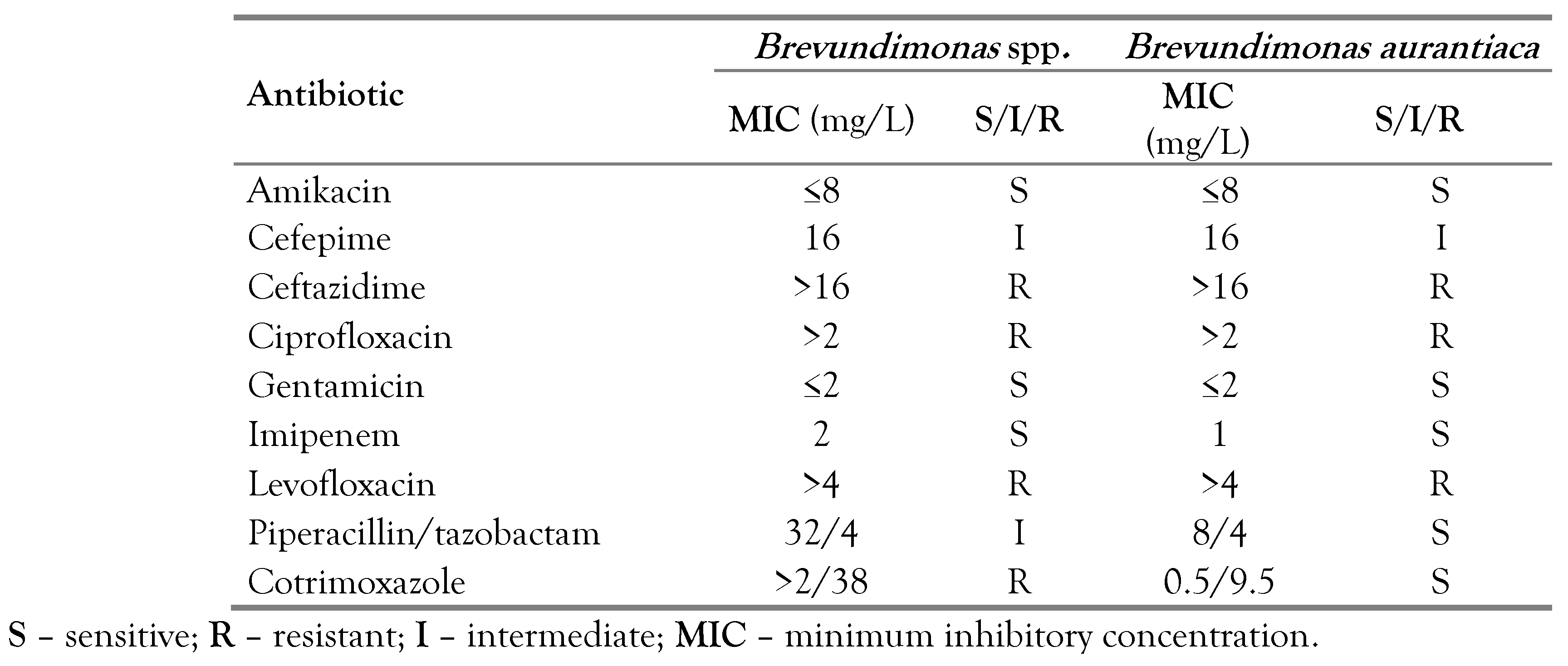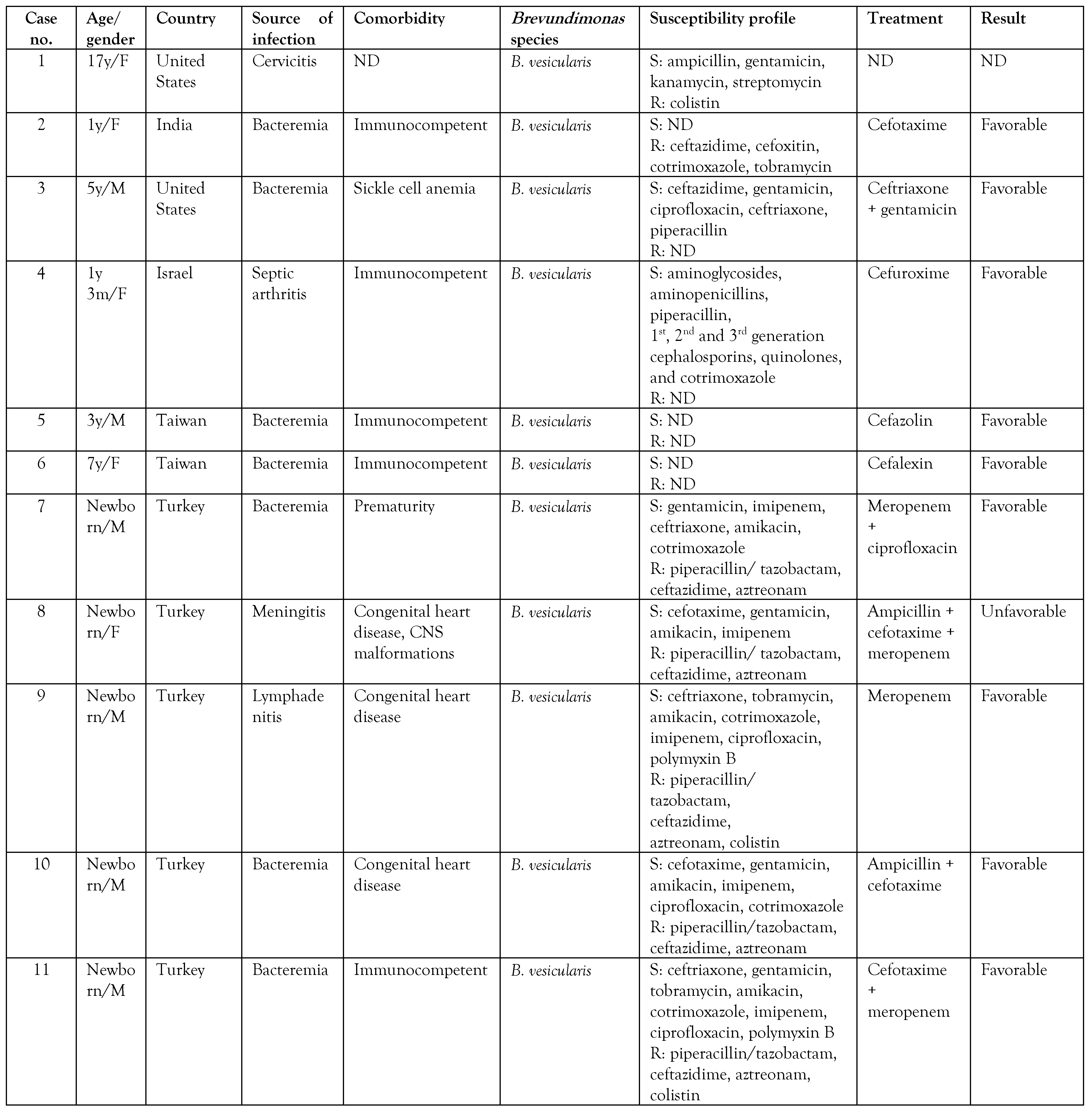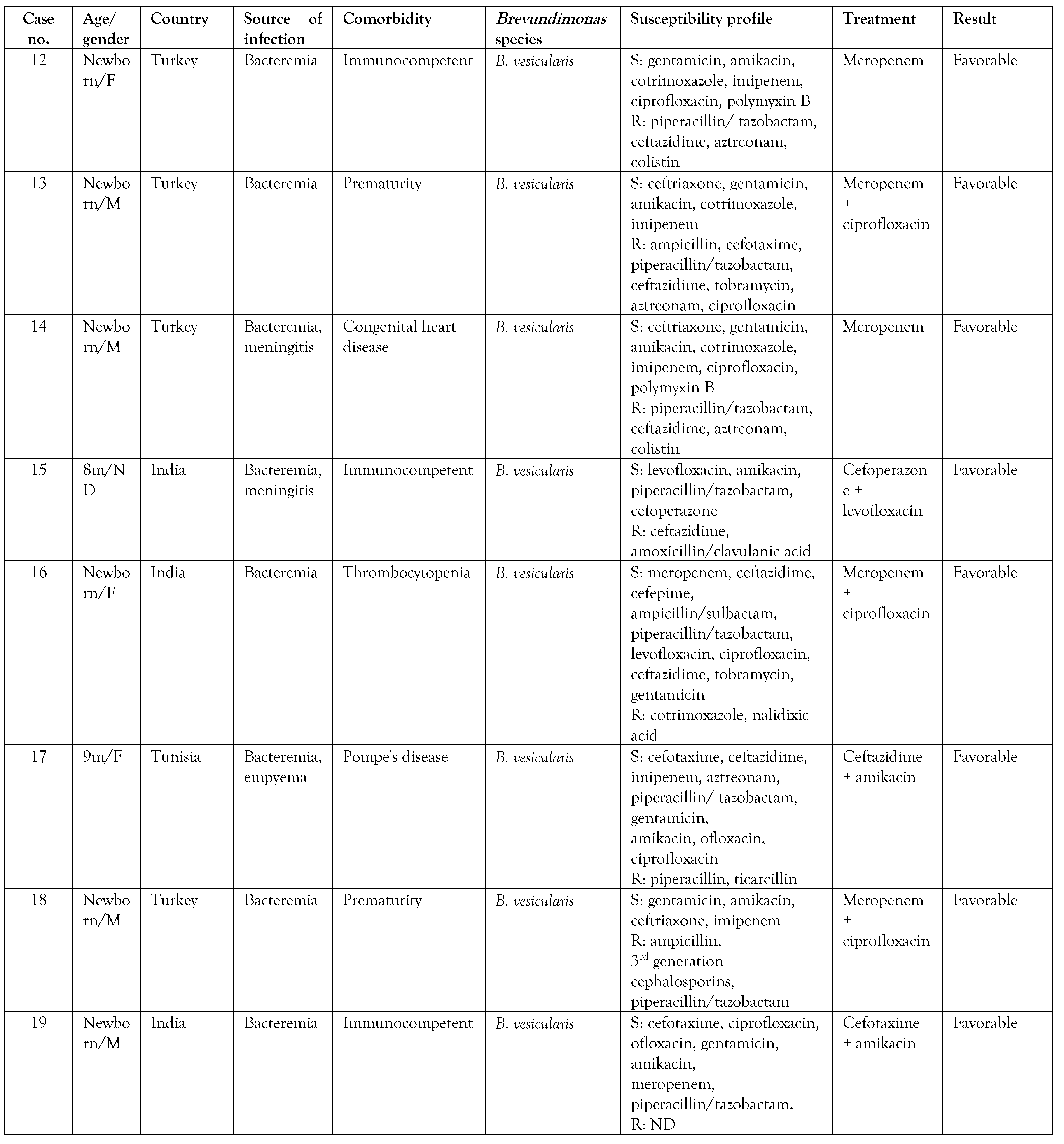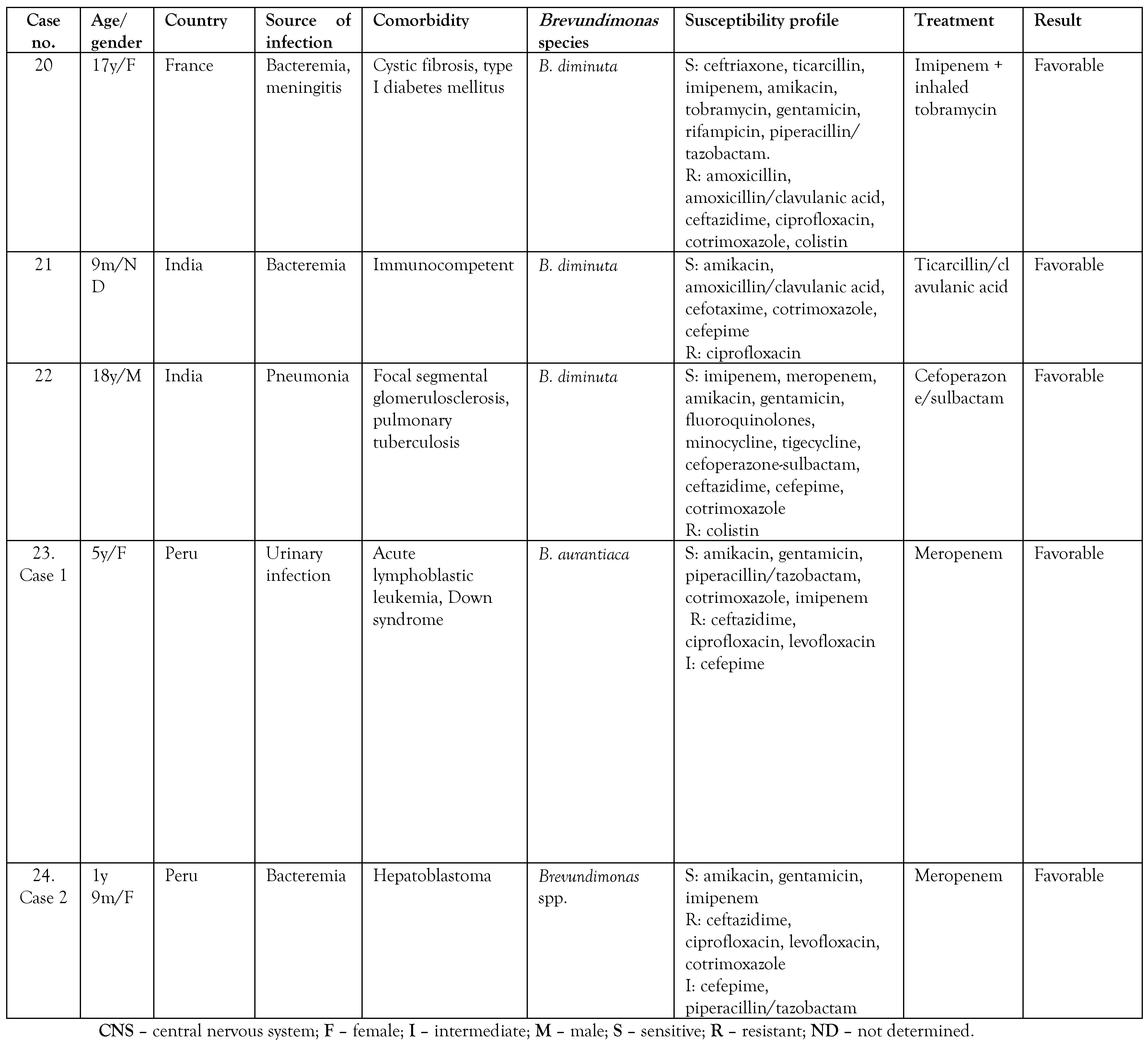Brevundimonas spp. Infection in Immunocompromised Children: Two Case Reports
Abstract
Introduction
Case reports
Case 1
Case 2
Discussion
Conclusions
Author Contributions
Funding
Ethics Approval
Consent
Conflicts of Interest
References
- Ryan, M.P.; Pembroke, J.T. Brevundimonas spp: Emerging global opportunistic pathogens. Virulence 2018, 9, 480–493. [Google Scholar] [CrossRef]
- Segers, P.; Vancanneyt, M.; Pot, B.; et al. Classification of Pseudomonas diminuta Leifson and Hugh 1954 and Pseudomonas vesicularis Büsing, Döll, and Freytag 1953 in Brevundimonas gen. nov. as Brevundimonas diminuta comb. nov. and Brevundimonas vesicularis comb. nov., respectively. Int J Syst Bacteriol 1994, 44, 499–510. [Google Scholar] [CrossRef]
- LPSN—List of prokaryotic names with standing in nomenclature. 2022. Available online: https://www.bacterio.net/genus/brevundimonas (accessed on 13 June 2022).
- Tsubouchi, T.; Shimane, Y.; Usui, K.; et al. Brevundimonas abyssalis sp. nov., a dimorphic prosthecate bacterium isolated from deep-subsea floor sediment. Int J Syst Evol Microbiol 2013, 63, 1987–1994. [Google Scholar] [CrossRef]
- Han, X.Y.; Andrade, R.A. Brevundimonas diminuta infections and its resistance to fluoroquinolones. J Antimicrob Chemother 2005, 55, 853–859. [Google Scholar] [CrossRef]
- Karadag, N.; Karagol, B.S.; Kundak, A.A.; et al. Spectrum of Brevundimonas vesicularis infections in neonatal period: A case series at a tertiary referral center. Infection 2012, 40, 509–515. [Google Scholar] [CrossRef]
- De Vegas, E.Z.; Nieves, B.; Araque, M.; et al. Outbreak of infection with Acinetobacter strain RUH 1139 in an intensive care unit. Infect Control Hosp Epidemiol 2006, 27, 397–403. [Google Scholar] [CrossRef]
- Bhatawadekar, S.M.; Sharma, J. Brevundimonas vesicularis bacteremia: A rare case report in a female infant. Indian J Med Microbiol 2011, 29, 420–422. [Google Scholar] [CrossRef]
- Oberhelman, R.A.; Humbert, J.R.; Santorelli, F.W. Pseudomonas vesicularis causing bacteremia in a child with sickle cell anemia. South Med J 1994, 87, 821–822. [Google Scholar] [CrossRef]
- Viswanathan, R.; Singh, A.; Mukherjee, R.; Sardar, S.; Dasgupta, S.; Mukherjee, S. Brevundimonas vesicularis: A new pathogen in newborn. J Pediatr Infect Dis 2010, 5, 189–191. [Google Scholar] [CrossRef]
- Menuet, M.; Bittar, F.; Stremler, N.; et al. First isolation of two colistin-resistant emerging pathogens, Brevundimonas diminuta and Ochrobactrum anthropi, in a woman with cystic fibrosis: A case report. J Med Case Rep 2008, 2, 373. [Google Scholar] [CrossRef]
- Sofer, Y.; Zmira, S.; Amir, J. Brevundimonas vesicularis septic arthritis in an immunocompetent child. Eur J Pediatr 2007, 166, 77–78. [Google Scholar] [CrossRef]
- Otto, L.A.; Deboo, B.S.; Capers, E.L.; Pickett, M.J. Pseudomonas vesicularis from cervical specimens. J Clin Microbiol 1978, 7, 341–345. [Google Scholar] [CrossRef]
- Singh, S.; Bhatia, B.D. Brevundimonas septicemia: A rare infection with rare presentation. Indian Pediatr 2015, 52, 901. [Google Scholar] [CrossRef]
- Bolzon, C.; Nguyen, B.H. A rare case of peritonitis due to Brevundimonas vesicularis. J Community Hosp Intern Med Perspect 2018, 8, 161–162. [Google Scholar] [CrossRef]
- Shobha, K.L.; Ramachandra, L.; Gowrish, S.; Nagalakshmi, N. Brevundimonas diminuta causing urinary tract infection. WebmedCentral Microbiol 2013, 4, WMC004411. [Google Scholar]
- Zhang, C.C.; Hsu, H.J.; Li, C.M. Brevundimonas vesicularis bacteremia resistant to trimethoprim-sulfamethoxazole and ceftazidime in a tertiary hospital in southern Taiwan. J Microbiol Immunol Infect 2012, 45, 448–452. [Google Scholar] [CrossRef]
- Nandy, S.; Das, A.K.; Dudeja, M.; Tiwari, R.; Alam, S. Brevundimonas vesicularis bacteremia in a neonate: A rare case report. Natl J Integr Res Med 2013, 4, 168–170. [Google Scholar]
- Ben Haj Khalifa, A.; Bouzidi, H.; Sfar, M.T.; Kheder, M.; Ayadi, A. Bactériémie à Brevundimonas vesicularis chez un nourrisson atteint de la maladie de Pompe. Med Mal Infect 2012, 42, 370–371. [Google Scholar] [CrossRef]
- Karadag, N.; Karagol, B.S.; Dursun, A.; Okumus, N.; Tanir, G.; Zenciroglu, A. A premature neonate with early-onset neonatal sepsis owing to Brevundimonas vesicularis complicated by persistent meningitis and lymphadenopathy. Paediatr Int Child Health 2012, 32, 239–241. [Google Scholar] [CrossRef]
- Chandra, A.; Das, A.; Sen, M.; Sharma, M. Brevundimonas diminuta infection in a case of nephrotic syndrome. Indian J Pathol Microbiol 2017, 60, 279–281. [Google Scholar] [CrossRef]
- Soto, J.E.V.; Parra, J.C.; López, C.E.M.; Marcos, M.C.; Romero, I.S.; Forteza, A. First report of Brevundimonas aurantiaca human infection: Infective endocarditis on aortic bioprostheses and supracoronary aortic graft acquired by water dispenser of domestic refrigerator. Int J Infect Dis 2022, 122, 8–9. [Google Scholar] [CrossRef]
- Laffineur, K.; Janssens, M.; Charlier, J.; Avesani, V.; Wauters, G.; Delmée, M. Biochemical and susceptibility tests useful for identification of nonfermenting gram-negative rods. J Clin Microbiol 2002, 40, 1085–1087. [Google Scholar] [CrossRef]
- Scotta, C.; Juan, C.; Cabot, G.; et al. Environmental microbiota represents a natural reservoir for dissemination of clinically relevant metallo-beta-lactamases. Antimicrob Agents Chemother 2011, 55, 5376–5379. [Google Scholar] [CrossRef]
- Almuzara, M.N.; Barberis, C.M.; Rodríguez, C.H.; Famiglietti, A.M.; Ramirez, M.S.; Vay, C.A. First report of an extensively drug-resistant VIM-2 metallo-β-lactamase-producing Brevundimonas diminuta clinical isolate. J Clin Microbiol 2012, 50, 2830–2832. [Google Scholar] [CrossRef]

© GERMS 2023.
Share and Cite
Altamirano-Beltrán, A.; Chiara-Chilet, C.; López, J.W.; Pons, M.J.; Maquera-Afaray, J. Brevundimonas spp. Infection in Immunocompromised Children: Two Case Reports. GERMS 2023, 13, 72-79. https://doi.org/10.18683/germs.2023.1369
Altamirano-Beltrán A, Chiara-Chilet C, López JW, Pons MJ, Maquera-Afaray J. Brevundimonas spp. Infection in Immunocompromised Children: Two Case Reports. GERMS. 2023; 13(1):72-79. https://doi.org/10.18683/germs.2023.1369
Chicago/Turabian StyleAltamirano-Beltrán, Andreé, Christian Chiara-Chilet, José W. López, Maria J. Pons, and Julio Maquera-Afaray. 2023. "Brevundimonas spp. Infection in Immunocompromised Children: Two Case Reports" GERMS 13, no. 1: 72-79. https://doi.org/10.18683/germs.2023.1369
APA StyleAltamirano-Beltrán, A., Chiara-Chilet, C., López, J. W., Pons, M. J., & Maquera-Afaray, J. (2023). Brevundimonas spp. Infection in Immunocompromised Children: Two Case Reports. GERMS, 13(1), 72-79. https://doi.org/10.18683/germs.2023.1369







